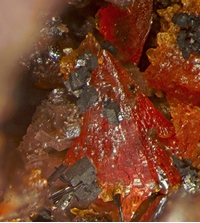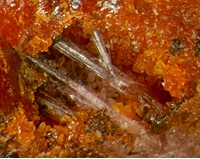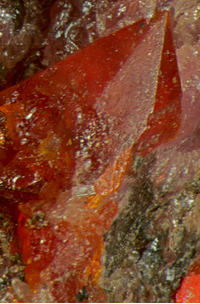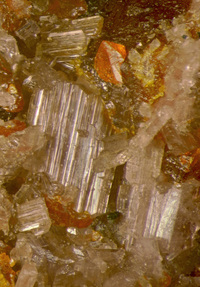
Zincite : ZnO, Leucophoenicite : Mn2+7(SiO4)3(OH)2, Franklinite : Zn2+Fe3+2O4
How to use the mindat.org media viewer
Click/touch this help panel to close it.
Welcome to the mindat.org media viewer. Here is a quick guide to some of the options available to you. Different controls are available depending on the type of media being shown (photo, video, animation, 3d image)
Controls - all media types
Zoom in and out of media using your mousewheel or with a two-finger 'resize' action on a touch device.
Use the mouse or your finger to drag the image or the view area of the image around the screen.
< and > at the left and right hand side of the screen move forwards and backwards for the other images associated with the media you selected. Usually this is used for previous/next photo in a gallery, in an article or in search results. Keyboard shortcuts: use shift + the left and right arrow keys.
< and > in the bottom center are used for switching between the photos of the same specimen. Keyboard shortcuts: use the left and right arrow keys.
> in the bottom center, raises the information box giving details and further options for the media, < at the top of this box then hides it. Keyboard shortcuts: use the up and down arrow keys.
? opens this help window. Keyboard shortcuts: use the H key or the ? key.
Other keyboard shortcuts:
| 1 | Fit image to screen |
| 2 | Fill screen with image |
| 5 | Display at full resolution |
| < | Make background darker |
| > | Make background lighter |
| space | Hide/dim titles and buttons |
Scalebar
If the field of view (FOV) is specified for the photo, the scalebar appears in the left bottom corner of the viewer. The scalebar is draggable and resizeable. Drag the right edge to resize it. Double click will reset the scalebar to it's default size and position. If the scalebar is in default position, double click will make it circular.
Controls - Video
Video files have a standard set of video controls:  - Reset to start,
- Reset to start,  - Skip back,
- Skip back,  - Play,
- Play,  - Pause,
- Pause,  - Skip forwards. Keyboard shortcuts: You can stop/start video play with the P key.
- Skip forwards. Keyboard shortcuts: You can stop/start video play with the P key.
Controls - Animation (Spin Rotation)
Animation (usually 360 degree spin rotations) have their own controls:  - enable spin mode. Note that while images are loading this option will not be available but will be automatically activated when the animation has loaded. Once active you can spin the image/change the animation by moving your mouse or finger on the image left/right or by pressing the [ or ] keys.
- enable spin mode. Note that while images are loading this option will not be available but will be automatically activated when the animation has loaded. Once active you can spin the image/change the animation by moving your mouse or finger on the image left/right or by pressing the [ or ] keys.
The  button switches to move mode so that you can use your mouse/fingers to move the image around the screen as with other media types.
button switches to move mode so that you can use your mouse/fingers to move the image around the screen as with other media types.
The  button, or the P key will start playing the animation directly, you can interrupt this by using the mouse or finger on the image to regain manual movement control.
button, or the P key will start playing the animation directly, you can interrupt this by using the mouse or finger on the image to regain manual movement control.
Controls - 3D Stereoscopic images
If a stereoscopic 3D image is opened in the viewer, the 3D button appears in the bottom right corner giving access to "3D settings" menu.
The 3D images can be viewed in several ways:
- without any special equipment using cross-eyed or parallel-eyed method
- with stereoscope
- with anaglyph glasses.
- on a suitable 3D TV or monitor (passive 3D system)
For details about 3D refer to: Mindat manuals: Mindat Media Viewer: 3D
To enable/disable 3D stereo display of a compatible stereo pair image press the 3 key. If the left/right images are reversed on your display (this often happens in full-screen mode) press the 4 key to reverse them.
Controls - photo comparison mode
If a photo with activated comparison mode is opened in the viewer, the
 button appears in the bottom right corner giving access to "Comparison mode settings" menu.
button appears in the bottom right corner giving access to "Comparison mode settings" menu.
Several layouts are supported: slider and side by-side comparison with up to 6 photos shown synchronously on the screen. On each of the compared photos a view selector is placed, e.g.: Longwave UV ▼. It shows the name of currently selected view and allows to select a view for each placeholder.
Summary of all keyboard shortcuts
| 1 | Fit image to screen |
| 2 | Fill screen with image |
| 3 | Switch to 3D display of stereo pair |
| 4 | Switch left/right images in 3D mode |
| 5 | Display at full resolution |
| <, > | Make background darker/lighter |
| H or ? | Show/hide this help page |
| P | Play/Pause Video or Animation |
| [, ] | Backwards/forwards one frame (Animation only) |
| space | Hide/dim titles and buttons |
| up arrow | Show information box |
| down arrow | Hide information box |
| left arrow | Previous child photo |
| right arrow | Next child photo |
| shift + left arrow | Previous image on the page |
| shift + right arrow | Next image on the page |


Zincite : ZnO, Leucophoenicite : Mn2+7(SiO4)3(OH)2, Franklinite : Zn2+Fe3+2O4
Largest Crystal Size: 2 mm




























Small embedded zincite xls such as this one suggested the presence of a hidden vein in granular (red) zincite, (lavender pink) leucophoenicite, (black) franklinite ore. There was indeed a small vein containing free standing zincite xls as well as leucophoenecite and pyrochroite xls. (See http://www.mindat.org/photo-165311.html for the latter.)
The child photos show some of the zincite xls, an overall view of the vein as well as black (!) chlorophoenicite. See Updates below for further discussion of this "black chlorophoenicite".
May 2016: I have replaced the parent image with a perhaps clearer image. The original parent photo was retained as a child image. Several new photos of other zincite crystals on this specimen have also been added. Two of these ar interestingly encrusted with pseudo-cubic pyrochroite crystals. Strangely, one of the encrusted zincite crystals appears to be tabular and rectangular. I have no explanation for this, but here is a direct link to that photo if you want to see for yourself without slogging through all of the "related" photos: [http://www.mindat.org/photo-749076.html].
I have also added a photo of colorless (i.e. not stained black) chlorophoenicite from a small isolated vug. These crystals have the same habit as the ones that are stained jet black, so the chlorophoenicite ID of the latter seems secure. (But see later updates below.)
In addition, there are numerous well-formed leucophoenicite crystals. These have been posted under a different parent photo, but I have now made the minIDs for both sets of photos the same so that all the photos will show up as "related".
Note added July 2020: The EDS scan for a sample of the "stained chlorophoenicite" turned out to be nearly identical to that for a sample of Zn rich pyrochroite from the Sterling Mine. In particular, no trace of As was seen, which means that it can't be chlorophonicite. Nor can it be "mineral E of Dunn", as had been speculated. See [https://www.mindat.org/photo-165501.html] and/or [https://www.mindat.org/photo-930212.html] for a discussion and [https://www.mindat.org/photo-1004732.html] for the scan. It is very hard to interpret this result. Possibly some further work on this material can be carried out in the near future. (See updates below.)
Second note added July 2020: I recently broke off two more fragments from this specimen. These revealed numerous small cavities with beautiful unstained leucophoenicite crystals along with more of the "chlorophoenicite" blades - both stained and unstained. I will post photos of a few of the best of these as time permits. More directly related to this particular photo, is the fact that in the course of splitting the specimen, one of the new fragments detached itself along a line running exactly along one edge of the zincite crystal pictured here. Talk about living dangerously! But risks can have rewards, and in this case, one of the rewards was that this crystal is now almost fully exposed on one side. I have added a new child photo showing one of the previously hidden faces. Because there are so many other "child" and "related" photos, here is a direct link to the new photo so as to make it easy to find: [https://www.mindat.org/photo-1063460.html].
Preliminary update Nov 2020: Recent analysis indicates that the "black chlorophoenicite" does, in fact have As (in fact lots of it), and per EDS, Raman and XRD is "chlorophoenicite-like", so quite possibly it is actulaly "mineral E of Dunn". See [https://www.mindat.org/photo-1101772.html] and other great photos of putative "mineral E" by Travis Olds as well as (e.g.) [https://www.mindat.org/photo-930212.html] and [https://www.mindat.org/photo-458374.html] which show particulary rich concentrations of the mineral.
Update June 2021: It now seems that the "pyrochroite" ID for the "black chlorophoenicite" must have been bogus. I don't know what went wrong, but clearly something did. There is, in fact, pyrochroite on the specimen. But it is all pseudo-cubic - it is not repalcing the bladed chlorophoenicite. The dark blades are probably "mineral E of Dunn". For details see [https://www.mindat.org/photo-930212.html].
Note added August 2023: See [https://www.mindat.org/photo-930212.html] for the status of "mineral E". Bottom line: The structure can't be determined with current technology from these samples.
This photo has been shown 1987 times